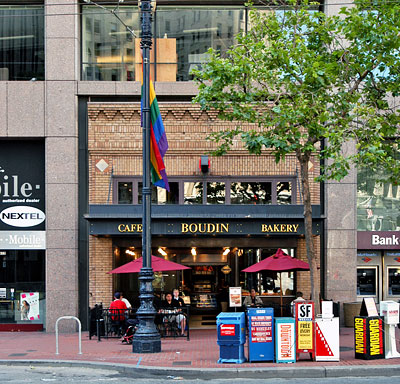San Francisco Landmarks
Hoffman Grill Building
AKA Hoffman's Grill
619 Market Street Between New Montgomery and 2nd Streets
Built 1913
The Hoffman Grill Building was declared a San Francisco landmark in 1981.
Five years later, the old building was gutted and surrounded by a highrise during the period when the San Francisco Planning Department insisted that new highrise buildings wear funny hats.
Only a few old bricks were incorporated into the façade of the new building.

City Planning Commission Resolution 9141 dated 17 September 1981 described the demolished building:
This modest building, designed by Woodworth Wethered in the Edwardian Eclectic style, was clearly designed to complement the hearty, no nonsense attitude of the establishment it houses. Located in the smallest remaining building on lower Market Street (25' by 91.5'), Hoffman's has been at the same address since 1913.
The building is faced with unpainted tan pressed brick laid up in a handsome pattern that features a marble insert at each corner of the enframed window wall. The restraint and economy of the design, typical of a number of post fire buildings, is increasingly admired as its counterparts are being replaced in the downtown district.
Although landmark designation does not extend to the interior of privately owned buildings, it must be noted that within is an original appearing Edwardian space. It is dominated by a great carved mahogany bar, back bar, mirrors, and art glass light fixtures attributed to Louis C. Tiffany. This wonderful interior exhibits a patina of age and use that would be impossible to duplicate either through reassembling original pieces or modern reproductions. The paneling, skylights, and general ambiance of the room can not be replicated.
The 19th Century European oil paintings on the walls grew from a collection started by M. J. Sullivan the original owner.

30 June 1984
Historic Hoffman's Grill, last relic of the pre-World War I restaurants on Market Street, closed June 29 with toasts to a vanished era. Hearty German fare, salty waiters, generous drinks and authentic atmosphere of stained glass, murky paintings and slow fans - that was Hoffman's.
"I really love this place," said owner Josef Betz, 44, who came to this country from Bavaria in 1962, was a Hoffman's waiter and ended up owning the joint.
He agreed to a $3 million settlement last month to vacate so that a 19-story office building can rise. Betz and his wife, Heide, an art gallery owner, get to keep $4.5 million in furniture and fixtures, leaving only a shell behind. Many customers asked Betz if he would move his restaurant.
"I hope so," Betz said. "We're looking around."
From the San Francisco Chronicle Archives

Façadism
Wikipedia defines Façadism (or Façadomy) as the practice of demolishing a building but leaving its façade intact for the purposes of building new structures in it or around it.
The International Charter for the Conservation and Restoration of Monuments and Sites (The Venice Charter of 1964) provided the doctrinal foundation for the modern preservation movement.
Although the United States did not participate in the preparation of the charter, the charter provided the basis for the Secretary of Interior's Standards for Historic Preservation. US/ICOMOS was founded in the 1960s to foster heritage conservation and historic preservation.
Article 1 of the Venice Charter
The concept of a historic monument embraces not only the single architectural work but also the urban or rural setting in which is found the evidence of a particular civilization, a significant development or a historic event. This applies not only to great works of art but also to more modest works of the past which have acquired cultural significance with the passing of time.
Article 7 of the Venice Charter
A monument is inseparable from the history to which it bears witness and from the setting in which it occurs. The moving of all or part of a monument cannot be allowed except where the safeguarding of that monument demands it or where it is justified by national or international interest of paramount importance.
Article 13 of the Venice Charter
Additions cannot be allowed except in so far as they do not detract from the interesting parts of the building, its traditional setting, the balance of its composition and its relation with its surroundings.
Paul Golderberger, writing in the New York Times on 15 July 1985 (Façadism on the Rise: Preservation or Illusion?), gives an argument against urban façadism.
For façadism holds out a great temptation. It seems, on the surface, to give both sides what they want. The small, older buildings valued by preservationists appear to be saved, while the large new ones developers seek can still be built.Façadism in San Francisco:But while façadism pretends to a certain earnestness, it is at bottom rather pernicious. For the compromise it represents is not really preservation at all. To save only the facade of a building is not to save its essence; it is to turn the building into a stage set, into a cute toy intended to make a skyscraper more palatable. And the street becomes a kind of Disneyland of false fronts.
- Belli Building, 722 Montgomery Street
- Borel and Company, 440 Montgomery Street
- Engine Company No. 14 , 1047 McAllister Street
- Genella Building, 726-728 Montgomery Street
- Hoffmann Grill Building, 619 Market Street
- Italian American Bank, 460 Montgomery Street
- South End District
- United States Mint & Subtreasury, 608 Commercial Street
- Minden Butter Manufacturing Company, Minden, NV
